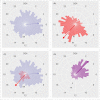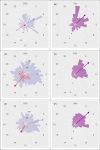Cyclical underreporting of seizures in patient-based seizure documentation
- PMID: 37608738
- PMCID: PMC10578895
- DOI: 10.1002/acn3.51880
Cyclical underreporting of seizures in patient-based seizure documentation
Abstract
Objective: Circadian and multidien cycles of seizure occurrence are increasingly discussed as to their biological underpinnings and in the context of seizure forecasting. This study analyzes if patient reported seizures provide valid data on such cyclical occurrence.
Methods: We retrospectively studied if circadian cycles derived from patient-based reporting reflect the objective seizure documentation in 2003 patients undergoing in-patient video-EEG monitoring.
Results: Only 24.1% of more than 29000 seizures documented were accompanied by patient notifications. There was cyclical underreporting of seizures with a maximum during nighttime, leading to significant deviations in the circadian distribution of seizures. Significant cyclical deviations were found for focal epilepsies originating from both, frontal and temporal lobes, and for different seizure types (in particular, focal unaware and focal to bilateral tonic-clonic seizures).
Interpretation: Patient seizure diaries may reflect a cyclical reporting bias rather than the true circadian seizure distributions. Cyclical underreporting of seizures derived from patient-based reports alone may lead to suboptimal treatment schemes, to an underestimation of seizure-associated risks, and may pose problems for valid seizure forecasting. This finding strongly supports the use of objective measures to monitor cyclical distributions of seizures and for studies and treatment decisions based thereon.
© 2023 The Authors. Annals of Clinical and Translational Neurology published by Wiley Periodicals LLC on behalf of American Neurological Association.
Conflict of interest statement
ASB has received research funding from EU and American Epilepsy Foundation for the assessment of seizure occurrence using wearables and EEG recordings, and receives research funding from the company UNEEG for an ongoing clinical multicenter trial on subcutaneous ultralong‐term EEG recordings. MR has received research funding from EU and American Epilepsy Foundation for the assessment of seizure occurrence using wearables and EEG recordings. The other authors have nothing to report.
Figures




Similar articles
-
Seizure Cycles in Focal Epilepsy.JAMA Neurol. 2021 Apr 1;78(4):454-463. doi: 10.1001/jamaneurol.2020.5370. JAMA Neurol. 2021. PMID: 33555292 Free PMC article.
-
Duration of focal complex, secondarily generalized tonic-clonic, and primarily generalized tonic-clonic seizures--A video-EEG analysis.Epilepsy Behav. 2015 Aug;49:111-7. doi: 10.1016/j.yebeh.2015.03.023. Epub 2015 Apr 29. Epilepsy Behav. 2015. PMID: 25935513
-
Forecasting seizure risk in adults with focal epilepsy: a development and validation study.Lancet Neurol. 2021 Feb;20(2):127-135. doi: 10.1016/S1474-4422(20)30396-3. Epub 2020 Dec 17. Lancet Neurol. 2021. PMID: 33341149 Free PMC article.
-
Idiopathic generalized epilepsies imitating focal epilepsies.Epilepsia. 2005;46 Suppl 9:91-5. doi: 10.1111/j.1528-1167.2005.00319.x. Epilepsia. 2005. PMID: 16302881 Review.
-
Cycles in Epilepsy.In: Noebels JL, Avoli M, Rogawski MA, Vezzani A, Delgado-Escueta AV, editors. Jasper's Basic Mechanisms of the Epilepsies. 5th edition. New York: Oxford University Press; 2024. Chapter 15. In: Noebels JL, Avoli M, Rogawski MA, Vezzani A, Delgado-Escueta AV, editors. Jasper's Basic Mechanisms of the Epilepsies. 5th edition. New York: Oxford University Press; 2024. Chapter 15. PMID: 39637099 Free Books & Documents. Review.
Cited by
-
The present and future of seizure detection, prediction, and forecasting with machine learning, including the future impact on clinical trials.Front Neurol. 2024 Jul 11;15:1425490. doi: 10.3389/fneur.2024.1425490. eCollection 2024. Front Neurol. 2024. PMID: 39055320 Free PMC article. Review.
-
Value of ultralong-term subcutaneous EEG monitoring for treatment decisions in temporal lobe epilepsy: A case report.Epilepsia Open. 2023 Dec;8(4):1616-1621. doi: 10.1002/epi4.12844. Epub 2023 Oct 25. Epilepsia Open. 2023. PMID: 37842739 Free PMC article.
-
How accurate do self-reported seizures need to be for effective medication management in epilepsy?Epilepsia. 2024 Jul;65(7):e104-e112. doi: 10.1111/epi.18019. Epub 2024 May 22. Epilepsia. 2024. PMID: 38776216 Free PMC article.
-
Seizure forecasting: Where do we stand?Epilepsia. 2023 Dec;64 Suppl 3(Suppl 3):S62-S71. doi: 10.1111/epi.17546. Epub 2023 Mar 8. Epilepsia. 2023. PMID: 36780237 Free PMC article.
-
Evaluating the accuracy of monitoring seizure cycles with seizure diaries.Epilepsia. 2025 May;66(5):1585-1598. doi: 10.1111/epi.18309. Epub 2025 Feb 24. Epilepsia. 2025. PMID: 39992689 Free PMC article.
References
-
- Griffiths G, Fox JT. Rhythm in epilepsy. Lancet. 1938;232(5999):409‐416.
MeSH terms
LinkOut - more resources
Full Text Sources
Medical
